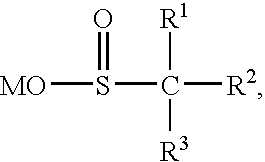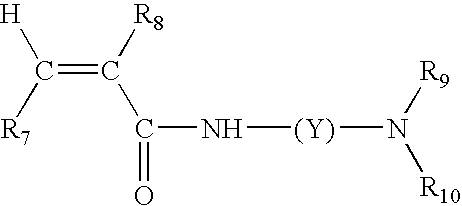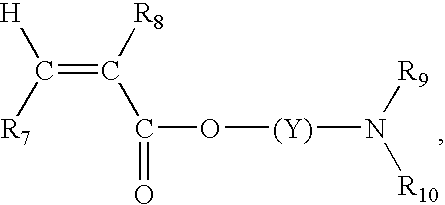Color-stable superabsorbent polymer composition
a superabsorbent polymer and composition technology, applied in the field of sap color degradation, can solve the problems of sap color degradation being too rapid, sap color degradation is too rapid, sap color degradation is not easy to be detected,
- Summary
- Abstract
- Description
- Claims
- Application Information
AI Technical Summary
Benefits of technology
Problems solved by technology
Method used
Image
Examples
example 1
[0156]An aqueous monomer mixture containing 25.6 wt. % sodium acrylate, 7.4 wt. % acrylic acid, 0.4 wt. % ethoxylated trimethylol propane triacrylate based on monomer (i.e., sodium acrylate plus acrylic acid), 0.025 wt. % 2-hydroxy-2-methyl-1-phenyl-propan-1-one (DAROCUR® 1173) based on monomer, 0.008 wt. % 2,2-dimethoxy-1,2-diphenylethan-1-one (IRGACURE® 651) based on monomer, and 0.02 wt. % a mixture containing 50-60% 2-hydroxy-2-sulfinatoacetic acid, disodium salt, 30-35% sodium sulfite, and 10-15% 2-hydroxy-2-sulfonatoacetic acid, disodium salt (BRUGGOLITE® FF6) based on monomer was prepared. The mixture was cooled to 15° C. and deoxygenated by bubbling a nitrogen stream through the mixture. Polymerization of the resulting monomer mixture then was initiated by addition of 0.04 wt. % hydrogen peroxide based on monomer and, after 5 minutes, the mixture was placed under a UV light (UV intensity=20 mW / cm2) for 15 minutes. The resulting gel was extruded three times through a KitchenA...
example 2
[0165]An aqueous monomer mixture containing 28 wt. % acrylic acid, 0.2 wt. % pentaerythritol triallyl ether based on acrylic acid, 0.025 wt. % sodium persulfate based on acrylic acid, 0.044 wt. % 2-hydroxy-2-methyl-1-phenyl-propan-1-one (DAROCUR® 1173) based on acrylic acid, 0.022 wt. % 2,2-dimethoxy-1,2-diphenylethan-1-one (IRGACURE® 651), and 0.025 wt. % 2-hydroxy-2-sulfinatoacetic acid, disodium salt (BRUGGOLITE® FF7) was prepared. The mixture was cooled to 15° C. and deoxygenated by bubbling a nitrogen stream through the mixture. Polymerization of the resulting monomer mixture then was initiated by addition of 0.05 wt. % hydrogen peroxide based on monomer and, after 5 minutes, the mixture was placed under a UV light (UV intensity=20 mW / cm2) for 20 minutes. The resulting polyacrylic acid gel was extruded through a KitchenAid Model K5SS mixer fitted with a meat grinder attachment. Next, sodium carbonate was added to the hydrogel, to adjust the neutralization degree of the acrylic ...
example 3
[0174]A 10 L capacity polyethylene vessel, well insulated by foamed polymer material, was charged with 3400 g of demineralized water and 1400 g of acrylic acid. N,N′-methylenbisacrylamide (2.8 g) then was added as copolymerization crosslinker. At a temperature of 10° C., 2.2 g of 2,2′-azobisamidinopropane dihydrochloride, dissolved in 25 g of demineralized water, and 0.28 g of hydrogen peroxide, dissolved in 150 g of demineralized water, were added in succession, and the mixture was stirred. The resulting solution then was deoxygenated by bubbling a nitrogen stream through the solution for 30 minutes, followed by the addition of 0.2 g of a mixture containing 50-60% 2-hydroxy-2-sulfinatoacetic acid, disodium salt, 30-35% of sodium sulfite and 10-15% of 2-hydroxy-2-sulfonatoacetic acid, disodium salt (BRUGGOLITE® FF6), dissolved in 25 g of demineralized water. The reaction solution then was allowed to stand without stirring, and the temperature of the polymerization rose to about 96° ...
PUM
| Property | Measurement | Unit |
|---|---|---|
| temperature | aaaaa | aaaaa |
| distance | aaaaa | aaaaa |
| temperature | aaaaa | aaaaa |
Abstract
Description
Claims
Application Information
 Login to View More
Login to View More - R&D
- Intellectual Property
- Life Sciences
- Materials
- Tech Scout
- Unparalleled Data Quality
- Higher Quality Content
- 60% Fewer Hallucinations
Browse by: Latest US Patents, China's latest patents, Technical Efficacy Thesaurus, Application Domain, Technology Topic, Popular Technical Reports.
© 2025 PatSnap. All rights reserved.Legal|Privacy policy|Modern Slavery Act Transparency Statement|Sitemap|About US| Contact US: help@patsnap.com



